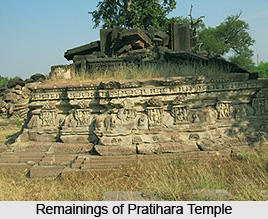 The caste system was prevalent during this period and the reference of all the four caste of the Vedic period is found in the inscription as well. The inscription refers the Brahmans as Vipra and several Prakrit wards are used for Kshatriyas. The people of each caste were divided into different classes. Chaturveda and Bhatta groups were prominent among the Brahmans. Among the Vaishyas the Kanchuka and Vakata groups were prominent. The Arab writer Ibda Khurdadab has referred seven castes in the time of the Pratiharas. According to him, there existed the classes of Savakfria, Brahman, Kataria, Sudaria, Bandalia and Labla. King was selected from the Savakufria class whereas people of Brahman class did not take wine and married their sons with the daughters of the Kataria class. The Kataria classes were regarded as Kshatriyas. The people of Sudaria were regarded as Sudras and usually did farming or cattle rearing. Basuria class was the Vaishya class whose duty was to serve other classes. The people of Sandila class did the work of Chandals. Lahuda class constituted of low and wandering tribe.
The caste system was prevalent during this period and the reference of all the four caste of the Vedic period is found in the inscription as well. The inscription refers the Brahmans as Vipra and several Prakrit wards are used for Kshatriyas. The people of each caste were divided into different classes. Chaturveda and Bhatta groups were prominent among the Brahmans. Among the Vaishyas the Kanchuka and Vakata groups were prominent. The Arab writer Ibda Khurdadab has referred seven castes in the time of the Pratiharas. According to him, there existed the classes of Savakfria, Brahman, Kataria, Sudaria, Bandalia and Labla. King was selected from the Savakufria class whereas people of Brahman class did not take wine and married their sons with the daughters of the Kataria class. The Kataria classes were regarded as Kshatriyas. The people of Sudaria were regarded as Sudras and usually did farming or cattle rearing. Basuria class was the Vaishya class whose duty was to serve other classes. The people of Sandila class did the work of Chandals. Lahuda class constituted of low and wandering tribe.
The above description of the Arab writer indicates that the Vaishyas did the work of the Sudars and the Sudar did the work of the Vishyas. It appears that the caste system was slowly and gradually breaking in a nice manner. The Brahmans started marrying kashatriya girls and the vaishyas performed the work of the sudras as well.
The Muslim attacks had begun during this period and many Hindus of the conquered states had been becoming the followers of Islam. It also appears that the Hindu society had allowed the purification of such Hindus. Smriti Ghandrayana Vrat, `Biladuri` and the writings of Aluberni and other Muslim writers also confirm this fact.
Some references of the inter caste marriage have also been found. The prominent Sanskrit scholar Rajasekhar had married Kshatriya girl named Avanti Sundari. Kings and the rich classes practiced polygamy. However, usually men had only one wife. It can also be known from some reference where on the death of their husbands, women had burnt themselves along with their husbands. Thus sati pratha was there though it was not very much prevalent.
There was no purdah system among the women of the royal families. According to Rajasekhar women learnt music, dancing and paintings. Women were very much fond of ornaments and also used oils and cosmetics. People of the rich families used to wear very thin clothes. The Arab writer Sulaman has written that in this period, silk used to be so thin and delicate that clothes made of it could pass through a ring.



















